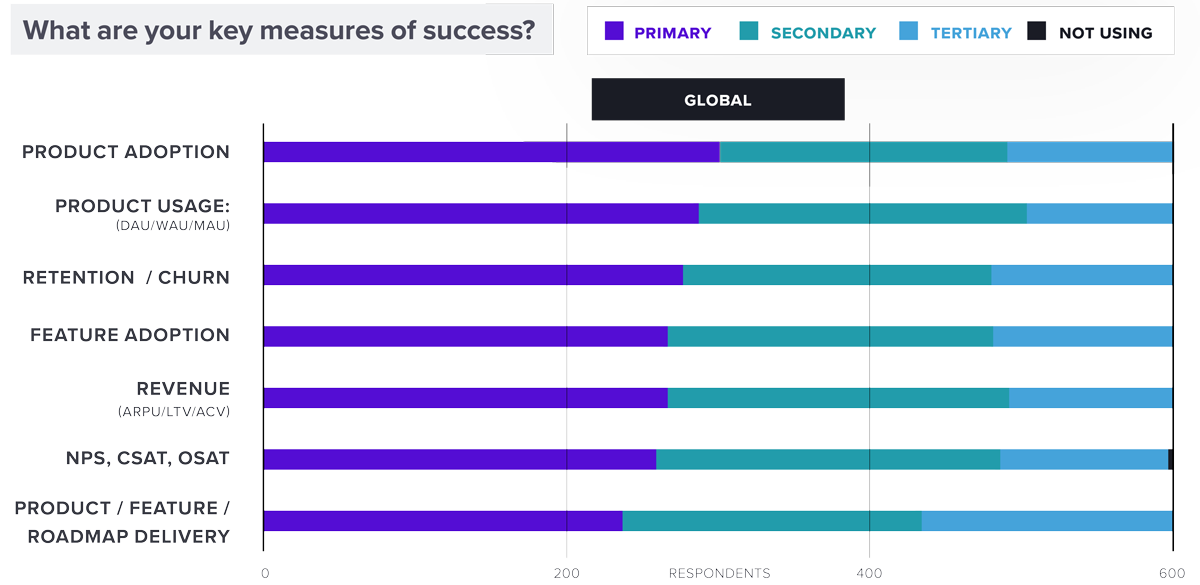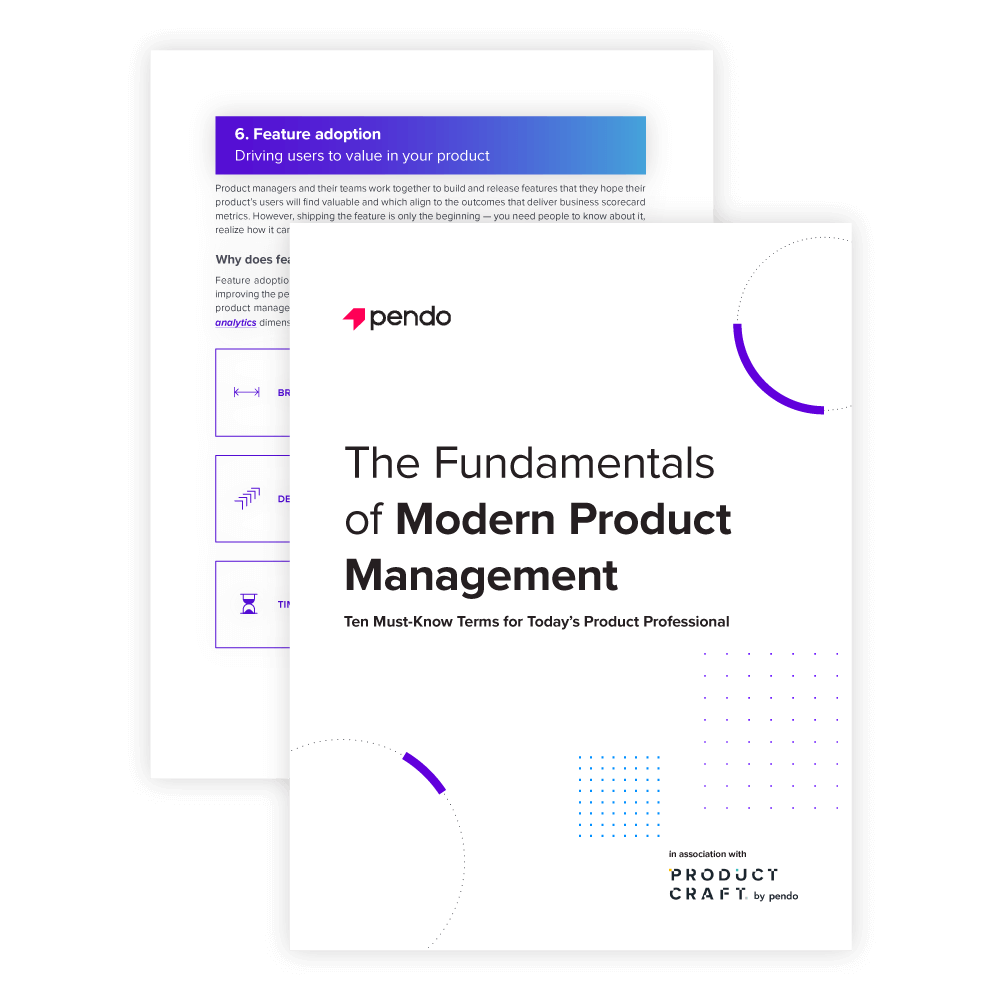
Ten Must-Know Terms for Today’s Product Professional
No matter your experience level or specific role within the product team, it can sometimes be helpful to revisit the basics. That’s why, in partnership with ProductCraft, our product management community, we’ve gathered a selection of “product management fundamentals” manuals into a single, easy-to-reference handbook. The ten terms we explore in this primer for the modern product professional are foundational to the understanding of this ever-evolving field.
In each section, we explain the basics of one key product management term, then dive into why it’s important for building successful products that will delight your users. You’ll also discover some tried-and-true best practices related to each concept and how they fit within the larger PM picture.
To learn more about each term (and get a list of recommended further reading), read the full articles on ProductCraft. We hope you find each one useful and enlightening.
1: Digital adoption
Accelerating your digital transformation
Are your users getting as much value out of your product as possible? How well have they integrated your application into their key workflows? Are they discovering and making use of a wide variety of helpful features? Or are they missing out on the aspects of your product that are most useful to them? Digital adoption concerns itself with these and similar questions.
デジタルアダプションが重要なのはなぜですか?
According to a 2018 report from analyst firm IDG, 89% of organizations plan to implement a digital-first business strategy. For companies that have already taken a digital-first approach, doing so increased revenue by 34% on average. Companies need to ensure the digital tools they procure are adopted by their users, whether those are their employees or customers. Digital adoption of internal software is typically measured by increased employee productivity, whereas customer-facing digital products are measured against various business KPIs and, for sophisticated organizations, product experience targets.
デジタル導入を増やすにはどうすればいいのか?
In addition to ensuring a product is as intuitive as possible, there are certain ways to help increase digital adoption across a company’s user base:
Onboarding – By creating an effective onboarding strategy, companies can ensure users not only become proficient in their application as quickly as possible, but also recognize the product’s value, which helps drive retention and prevent churn.
In-app guidance – In order to provide contextual information while users are in the product, many companies use in-app messaging to communicate at the right moments and guide users to success.
Ongoing education – Since digital adoption is an ongoing process, it’s important to continue educating users after onboarding is complete, especially when there are any product releases, changes, or updates.
Today, many companies are turning to digital adoption platforms [like Pendo] — software that is layered on top of another software product, app, or website to help facilitate proficiency by guiding users through key tasks and providing contextual information as users navigate the product — to implement these practices effectively.
2: Onboarding
Guiding your users to “aha” moments faster
One of the most — if not the most — important points in a product user’s journey is where it begins. That first step is referred to as onboarding, and it can make or break a user’s experience with a product. After all, you never get a second chance to make a first impression.
なぜユーザーオンボーディングが重要なのですか?
Onboarding happens whether the experience is curated or not. Companies that prioritize the onboarding experience can make their users proficient much more quickly. The growth of SaaS applications has dramatically reduced customers’ switching costs. They are much more likely to churn if they don’t realize value quickly, thus helping a customer accelerate time to value is key to churn prevention.
What are some best practices for user onboarding?
Here are a few of the ways your team can set users up for success:
Design onboarding experiences for each unique user segment
If the app serves different user roles, tailor onboarding to the specific needs of each persona. By designing onboarding for each unique type of user, companies can drive new users to their specific a-ha moments more quickly and deliver the context needed to keep users engaged.
Differentiate between new users and new accounts
For business-to-business products, each account likely has multiple users, with new team members joining regularly. A new user to an existing account can take a more streamlined onboarding if the primary account configuration has already taken place. In this scenario, the goal of user onboarding is to get the new team member up to speed on the existing account activity, not to establish the account from scratch.
Adjust for different learning styles
Think through different ways that users could progress through the onboarding experience. A company might design modularized onboarding content that allows users to explore topics in the order they prefer. Indicators like a progress bar or completion percentage are helpful, especially for longer, sequence-dependent onboarding. When possible, try to incorporate multiple communication modes, like video demos and illustrated walkthroughs. Finally, gamification can provide motivation and encourage onboarding completion.
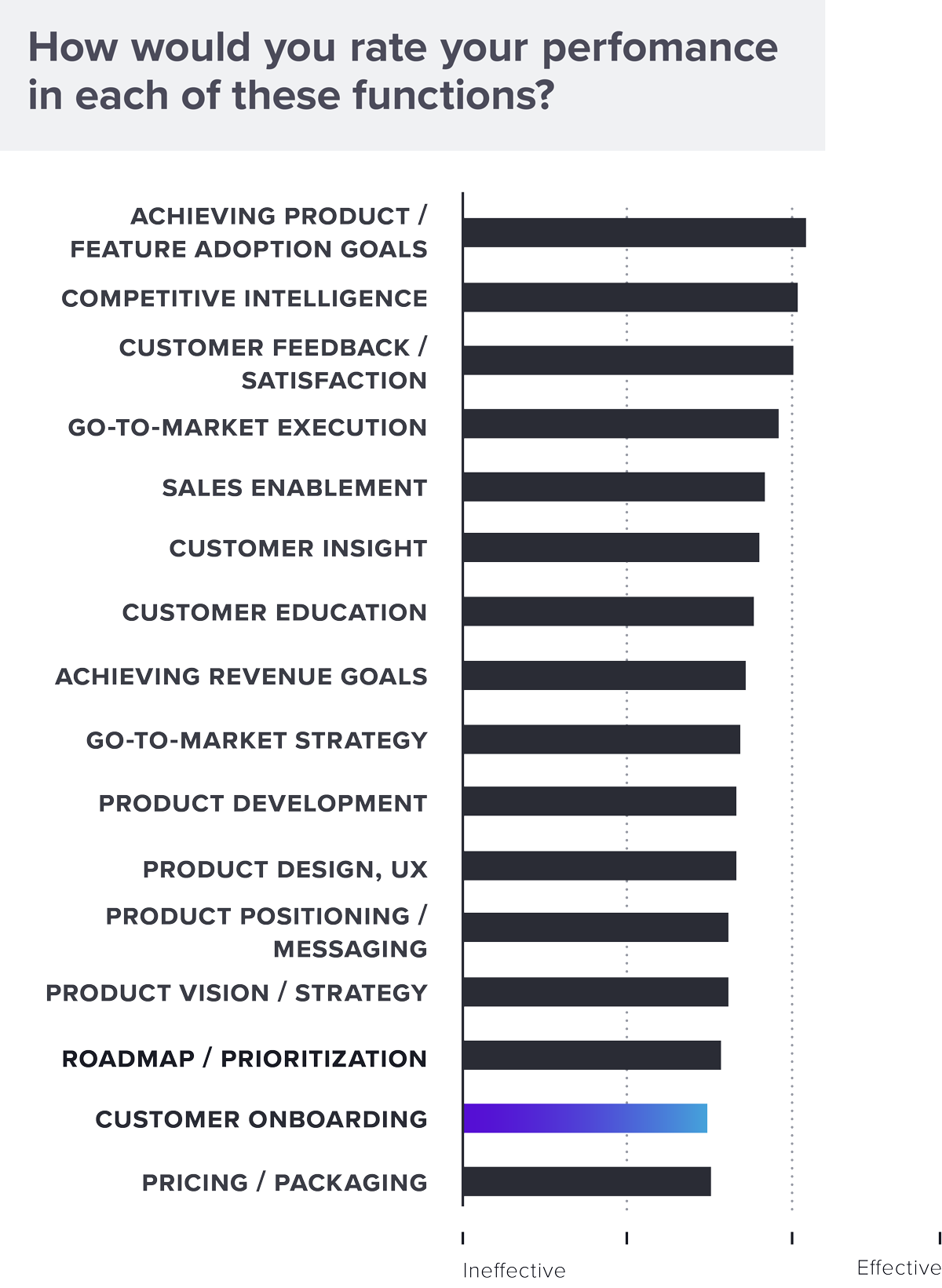
3: Customer experience
Putting your product at the center of the user journey
What is customer experience (CX), and how does it differ from product experience (PX)?
In the software industry, product experience (PX) refers to the portion of the customer journey that takes place within the application. It’s a narrower band of the overall customer experience. While customer experience continues after a customer leaves your product (and even after they churn), product experience is specific to their engagements with your product. As SaaS becomes the primary software delivery model, more of the customer’s engagement with a vendor takes place within the product. It’s where users get onboarded, where they learn new features, and where they ultimately realize value.
Why does CX matter?
Picture the feeling of delight when the software someone’s using for work helps them get something tedious off their desk quickly. That’s customer experience. But so is when someone gets bumped from a flight, and then their app tells them the flight is boarding.
Whether it’s positive or negative, the effects of customer experience linger. Good customer experience gains company ambassadors, which is more powerful than any marketing campaign. Subpar customer experience can gain a company notoriety — and this is not an example of “any publicity is good publicity.”
Creating a customer experience that delights, engages, and keeps customers coming back is critical to growth. The opposite is also true. Last year, a study from PWC found that 59% of consumers will stop interacting with a brand they love after just one bad experience! The stakes are simply too high to risk giving customers an experience that’s anything short of excellent, at every touchpoint.
どうすれば顧客体験を向上させることができますか?
As mentioned above, CX starts well before someone becomes a customer. It may begin with word of mouth, an online review, marketing materials, or a free trial. However, the first post-purchase step in the customer experience is often onboarding. Because onboarding is such a milestone step in the journey, it’s essential that companies make it intuitive, make it brief, and make sure it teaches the user the most important tenets of the product — all to expedite time to value.
NPSを使用して行われる継続測定は、プロダクトが時間の経過とともにどのように機能しているかを示します。また定性的なフィードバック、つまり「コメント」を収集する機会にもなります。この自由記入式のフィードバックは、定量化可能なデータに役立つ「コンテキスト」を提供します。
4: User segmentation
Creating targeted product experiences
ユーザーのセグメント化が重要な理由
User segmentation helps organizations understand their user base. While no two users may be alike, cohorting groups of similar users can expose the attributes common to a company’s most successful customers. For example, if one were to create user segments for trial users who convert vs. those who churn, the go-to-market team could learn how each segment uses the product differently, and then determine which marketing channels are more likely to attract those who tend to convert to paid users. Segmentation can also help product teams design different experiences for different types of users, with an eye toward increasing engagement, satisfaction, renewal, and expansion.
ユーザーのセグメント化の導入方法
Companies can begin implementing user segmentation by following a short list of steps.
Track individual behavior and sentiment
While some of the data required for segmentation will live in the company’s CRM system, product teams will also need to add information about product usage and sentiment with a product analytics tool. A key outcome from a user segmentation exercise is to understand how different groups use the product differently, so capturing product usage data is critical, and this is why product analytics is important.
Define user groups
Product and go-to-market teams should determine user groups based on the organization’s business objectives at the time. If the company is focused on new logo acquisition, for example, the teams might create segments for trial users who converted to paid vs. those who didn’t.
Compare activity between segments
User segmentation is valuable because it allows companies to compare and contrast different types of users. Comparing segments can help product and go-to-market teams understand how to turn happy customers into promoters, increase engagement levels for stalled users, or even shift resources away from certain segments entirely.
Experiment and measure impact on segments
Through experimentation and measurement, companies can learn which levers they can pull to affect change in a segment’s behavior, experience, or sentiment. And they can learn if those changes contribute to desired business outcomes.
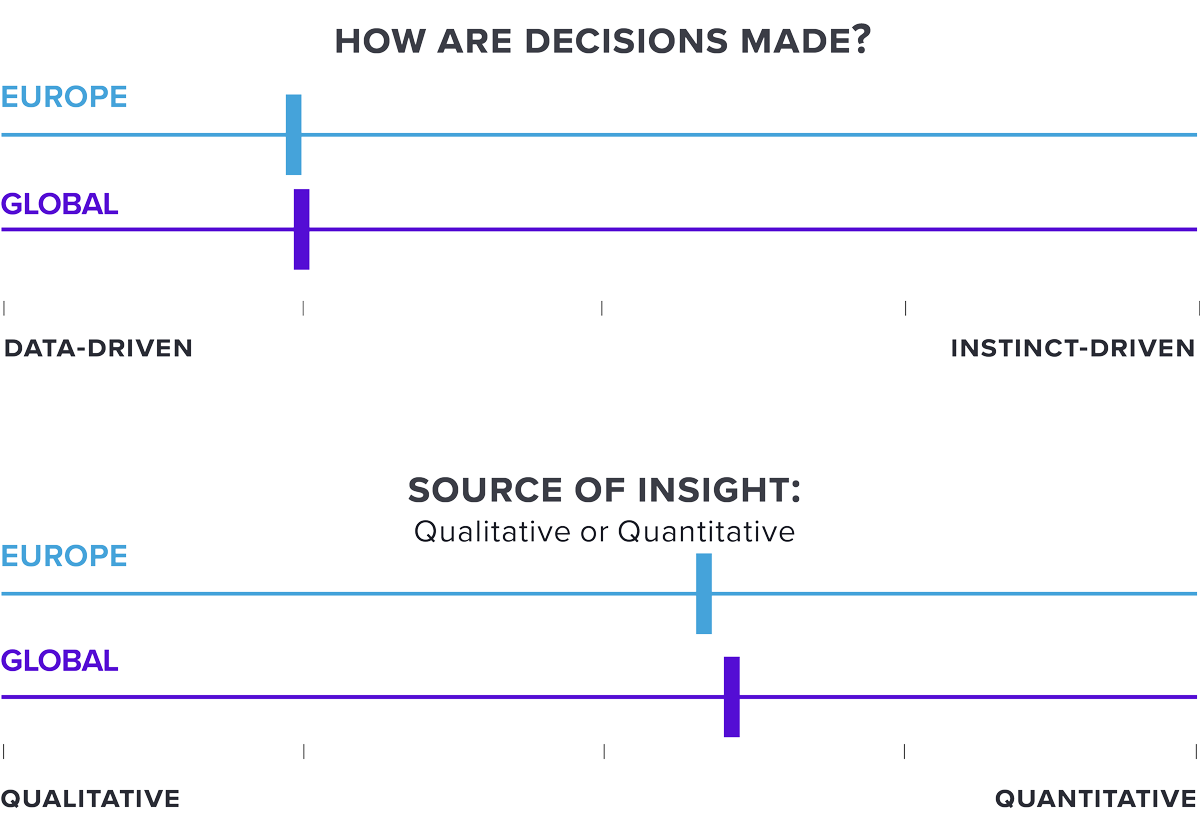
5: NPS
Understanding the factors behind customer satisfaction
How do you know if your customers are truly happy with your product? How can you identify your biggest fans and advocates, and/or your most unhappy and dissatisfied customers? The Net Promoter Score (or NPS) aims to answer these questions in a quantitative, measurable way.
Are there other measures of customer sentiment?
While NPS is likely the most commonly used and well-known measure of customer sentiment, it certainly isn’t the only one. Two other such metrics you’re likely to come across include CSAT (Customer Satisfaction Score) and CES (Customer Effort Score). Each of these KPIs has its own pros, cons, and use cases.
企業のネットプロモータースコアに影響を与える要因は何ですか?
特にソフトウェア企業にとって、アカウントレベルのNPSとユーザーレベルのNPSの違いを理解することは重要です。ユーザーNPSは、ソフトウェアを定期的に使用している人のスコアを収集したものです。その人はプロダクトに最も近いところにいるため、そのスコアはアカウントスコアよりも高い可能性があります。後者は、プロダクトからより遠いところにいて、あまり情報を持たない人の視点であるため、スコアが低くなる可能性があります。
NPS tracking can get sophisticated quickly. The medium over which the score is captured can also bias results. An NPS survey conducted within the product itself is likely to produce a higher score than an emailed survey, because the former is capturing a higher concentration of active, engaged users.
上記の点は、ユーザーNPSまたはアプリ内NPSを他と比べたときの価値の違いを示すことを意図したものではありません。バイアスを認識し、時間の経過とともにベンチマークを行うときに一貫性を保つことが役立つということだけです。
The method of collecting survey data isn’t the only factor that impacts an NPS score. The buying experience, onboarding process, and, of course, the product itself all have the potential to create Detractors and Promoters alike. To this end, understanding which pages or features in the product increase customer satisfaction and guiding users to those features is one of the most reliable ways to improve NPS over time.
6: Feature adoption
Driving users to value in your product
Product managers and their teams work together to build and release features that they hope their product’s users will find valuable and which align to the outcomes that deliver business scorecard metrics. However, shipping the feature is only the beginning — you need people to know about it, realize how it can help them, and eventually, to actually use it.
機能の定着化が重要なのはなぜですか?
Each new feature presents an opportunity for added value. Unused features, however, can have a converse effect. This is why customer success managers are often laser-focused on feature adoption, since key metrics like retention and expansion are contingent on minimizing time to value. Paying for unused features lowers a customer’s perceived value and, ultimately, affects their willingness to renew at the current price level (or at all).
機能の定着化アナリティクスとは何ですか?
機能の定着化アナリティクスでは、プロダクトマネージャーとカスタマーサクセスマネージャーの取り組みを、最も重要な機能の性能を向上させることに集中させます。機能のリリースを測定する場合、プロダクトマネージャーとカスタマーサクセスマネージャーは、次の4つの主要な機能の定着化アナリティクスの側面を考慮する必要があります。
Breadth of adoption
How widely has a feature been adopted across the user base or a targeted user segment? Has the feature been picked up by a majority of the targeted users or only a small percentage? Breadth of adoption shows the initial appeal of the new feature.
Depth of adoption
How often do key user types touch the feature? Are they applying a desired process to demonstrate stickiness? Are they behaving in unexpected ways? Depth of adoption can signal relevance for an ongoing need or difficulty of use, so it’s important to keep a close eye on it and solicit feedback, if possible.
Time to adopt
How long does it take for customers to begin using a new feature? When learning about a feature, do they immediately try it or do they wait days or weeks before using it? The more quickly a feature is adopted, the more likely it aligns to an existing pain point.
Duration of adoption
How long do users continue to use a feature after learning about it? Do they just try it out a few times or continue to use it over the course of months and years? Duration aligns to retention and helps show whether a feature is providing real value beyond its initial novelty, and can signal when a feature needs a refresh.
これらの側面で定着化を成功させる要因は、ユースケースによって異なりますが、機能リリースの結果を評価する際には、これら4つの要素をすべて考慮することが重要です。
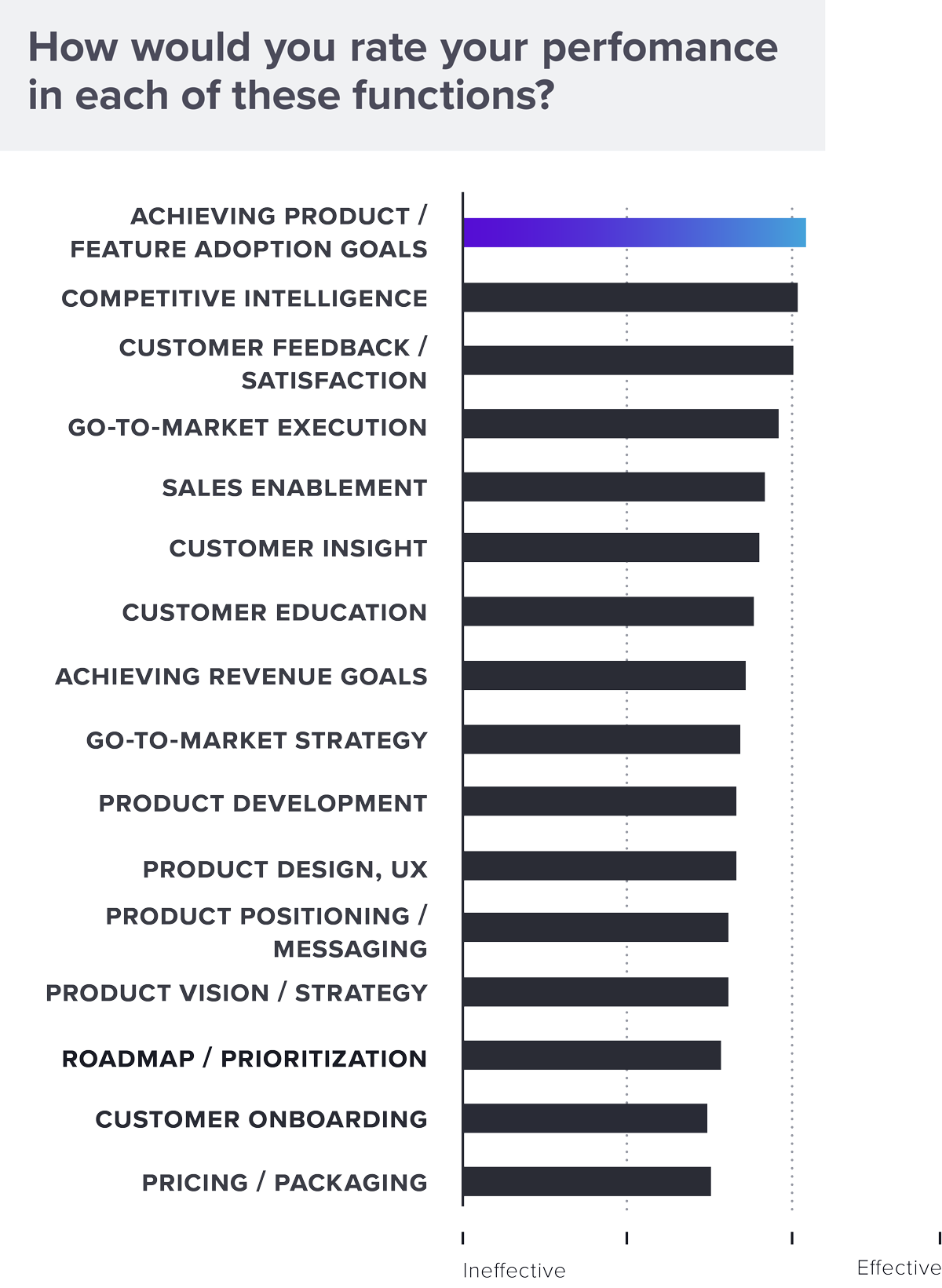
7: Feedback
Fueling your roadmap
Today’s PMs have access to huge amounts of data, but hard numbers are only one piece of the product experience puzzle. Qualitative feedback from customers and users is the other.
Why is feedback important?
Without feedback, a company will never know if customers are getting value out of their product. Without knowing if they’re getting value, the product and go-to-market teams won’t know if they’re nurturing loyal customers (not to mention be able to measure customer retention and customer health). And without loyal customers, well
According to Gartner, “customers’ salient experiences with the company heavily influence their long-term switching behavior and reflect the true drivers of loyalty.” How does one find out what their salient experiences were? Customer and/or user feedback.
顧客フィードバック戦略を改善するにはどうすればよいですか?
Make it timely
Emailing a survey to a user may be asking more than they’re willing to give, especially because reading the email pulls them out of the product. Instead, survey them in-app so they receive the question while they are using the product. In-app surveys yield more accurate feedback and typically have higher response rates.
Make it easy
Collecting feedback should be done on the customer’s terms, not the company’s. What does this mean? Well, if a customer has to dig around in the product to find a “contact us” form, then it’s not exactly easy for them to provide the feedback the product and marketing teams covet. An occasional survey is also not enough. Effective programs make the feedback mechanism as simple as possible, available to any customer, any time.
Make it smart
Customers may have more than one piece of feedback to share, but not all feedback is created equal. It should also be easy for customers to rank their feedback priority — let them share what is most pressing for them, so that product, marketing, and customer success teams can better prioritize their actions.
フィードバックの循環
Too often, companies collect feedback, but it ends up in a black hole, never to be synthesized or acted upon. Make sure the company has a clear vision and process in place before collecting feedback, as well as a tool to collect, prioritize, and manage feedback.
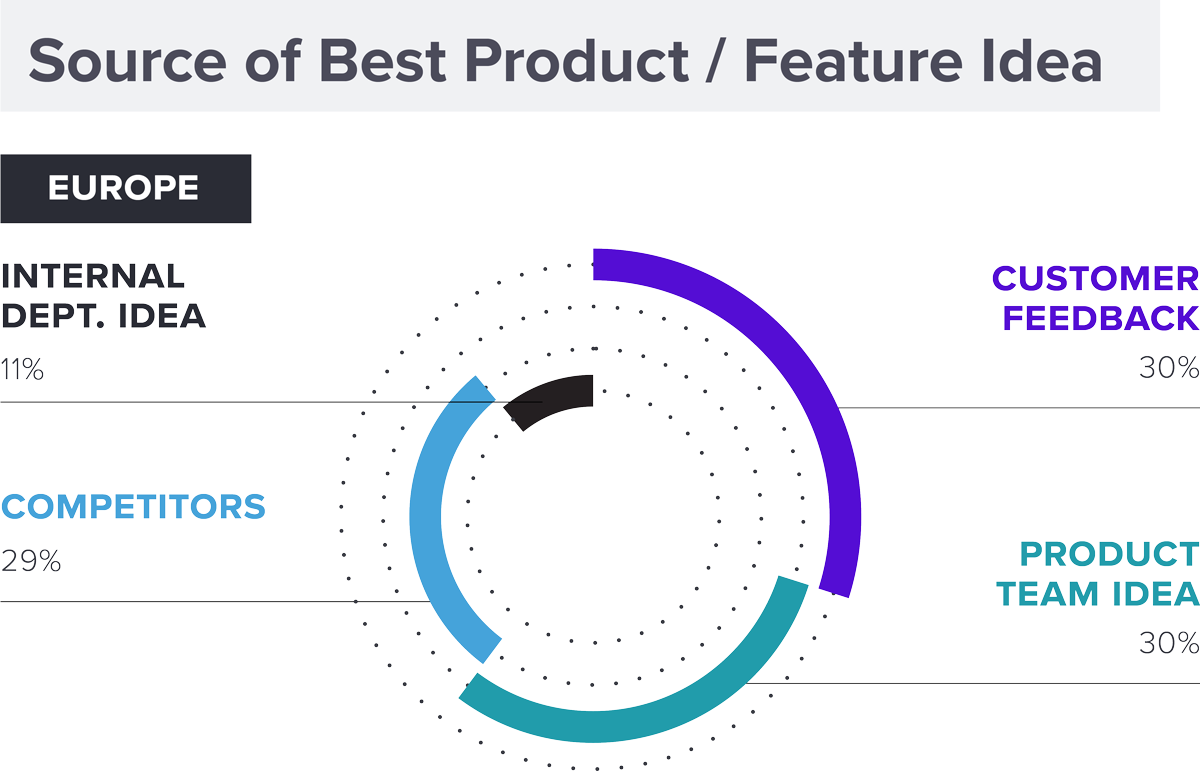
8: Roadmapping
Visualizing your product’s future
The roadmap is one of the most important “living documents” a product team has. It brings together multiple stakeholders around a shared plan for the product and sets general expectations of what will be completed and when.
プロダクトロードマップとは何ですか?
A product roadmap is a visual summary of a product’s direction to facilitate communication with customers, prospects, partners, and internal stakeholders. A product roadmap is not a backlog of tasks. It’s not a detailed project plan or list of tactical activities, nor a repository for customer feedback and/or feature requests. And definitely it’s not an ironclad plan for which features or products will be released when. In fact, roadmaps change quite frequently due to shifting priorities, market conditions, or a change in business strategy.
What is included in a product roadmap?
A basic roadmap will usually include feature and product releases, but most go beyond that. Some items that may appear on a product roadmap are:
- Feature releases
- Product releases
- Strategic milestones
- Business or team initiatives
- Goals
- Epics
- User stories
Who creates the product roadmap?
Generally, the creation and management of the product roadmap is the purview of the product team. However, they don’t do this in a vacuum. Input from a wide variety of sources should make its way into the roadmap. These sources typically include both internal stakeholders, such as executives, salespeople, and customer success team members, and external ones, like customers. Also, a roadmap isn’t a “one and done” project — product managers should continuously seek feedback related to the roadmap and update it as priorities shift and new data becomes available.
Are there different kinds of product roadmaps?
Definitely. Product teams often create roadmaps for specific audiences. For example, they might create a public-facing version to share with customers. Or they may build a sales-specific one to distribute to revenue team members. In addition, they may create versions that emphasize different things — one that’s feature-focused, and another that’s initiative-focused, for instance.
9: Product operations
Prioritising efficiency and organization
プロダクトオペレーションが重要なのはなぜですか?
For product-led companies, the product is the focal point for each stage of the customer journey — from trial and purchase all the way through onboarding, expansion, and referrals — and product ops is key to the optimization of that experience. Just as sales ops, marketing ops, and DevOps became essential for their respective teams, product teams also benefit from an operational complement.
Product ops pros are often responsible for helping product management make more reliable decisions by equipping them with relevant usage data. Because product data is collected automatically (no manual entry, like with a CRM, for example), it tends to be among the “cleanest” data available to decision-makers. Gartner predicts that by 2021, 75% of software providers will rely on insights from embedded software analytics to inform product decisions and measure customer health.
プロダクトオペレーションの仕事は?
プロダクトオペレーションの責任は、次の5つの中核的な分野に分類されます。
Tools: Similar to other ops roles, product ops manages the product tech stack, establishes internal best practices, and ensures team members are using tools effectively.
Data: Product ops collects, organizes, and analyzes quantitative and qualitative product data and enables the entire organization to make the most of their insights. Data can include everything from product usage data, Net Promoter Score (NPS), and product stickiness to customer feedback, feature requests, and support tickets.
実験:プロダクトの実験プロセス内の摩擦を排除するために、プロダクトオペレーションはすべての実験を追跡、順序付け、実行し、効率を高めるプロセスを作成します。
戦略:プロダクトオペレーションは、プロダクトに関する部門間のコラボレーションを促進し、プロダクトのインサイトを使用して、改善すべき領域を特定し、ビジネス上の意思決定に情報を提供します。
Trusted advisor: By providing product information to key decision-makers, product ops is an important advisor to CPOs, VPs of product, and other R&D leadership.
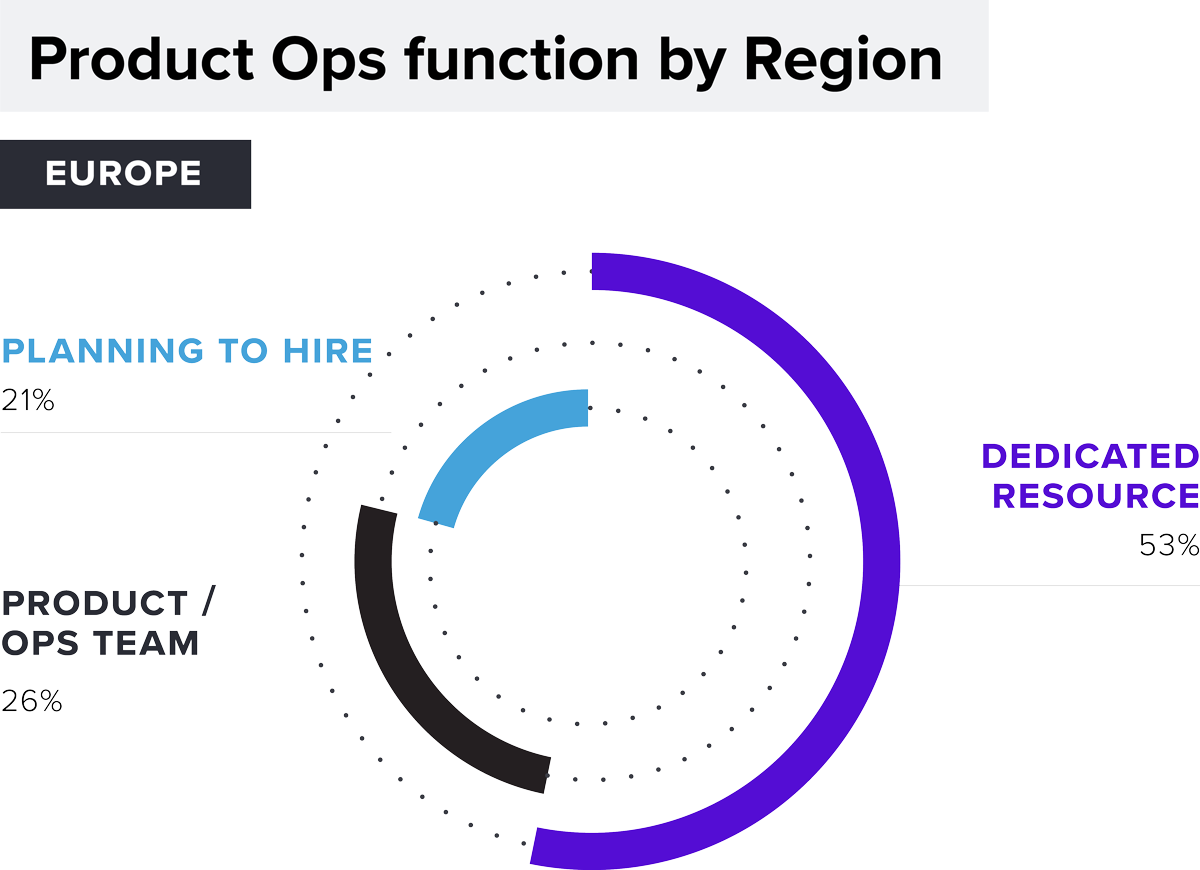
10: Retention
Building products that keep users coming back
Why is retention important?
User acquisition is expensive. Often it takes SaaS companies years before they can turn a profit on a new customer. Failing to retain customers means that every new business win results in a financial loss. Only by retaining customers past the payback period can an organization turn a profit on each customer.
ユーザーリテンションの原動力
オンボーディング
User retention starts with successful onboarding. A user must be able to execute product basics, like setting up their new account. If there are key configuration steps, such as completing an integration or inviting teammates, the user must be guided through those actions as quickly as possible.
アクティベーション
Once onboarding is complete, it’s critical that new users see immediate value from the product. Helping the user realize early wins builds momentum and motivates them to return.
Habit
The final step in driving user retention is creating usage habits. What triggers should prompt a user to come back to the product to complete another task? Combining user habits, like taking a photo of a receipt for expense-processing apps, with the natural usage frequency for the application can inform an organization’s onboarding and activation strategies.
顧客リテンションを測定するにはどうすればよいですか?
リテンションは、特定の期間の開始時の顧客数とその期間の終了時の顧客数を比較することによって測定されます。ただし、この方法では、この期間に獲得した新規顧客を除外する必要があります。
For example, a company that begins the year with 100 customers, acquires 10 new customers and loses 10 of the initial customers. By the end of the year, this company has 90% retention. Despite the fact that the number of customers remained the same — meaning growth is flat — only 90 customers are retained. Strong customer acquisition does not cover up low retention.
